The Ultimate Guide to Everest Base Camp Trek: Everything You Need to Know – By 25 years experienced guide
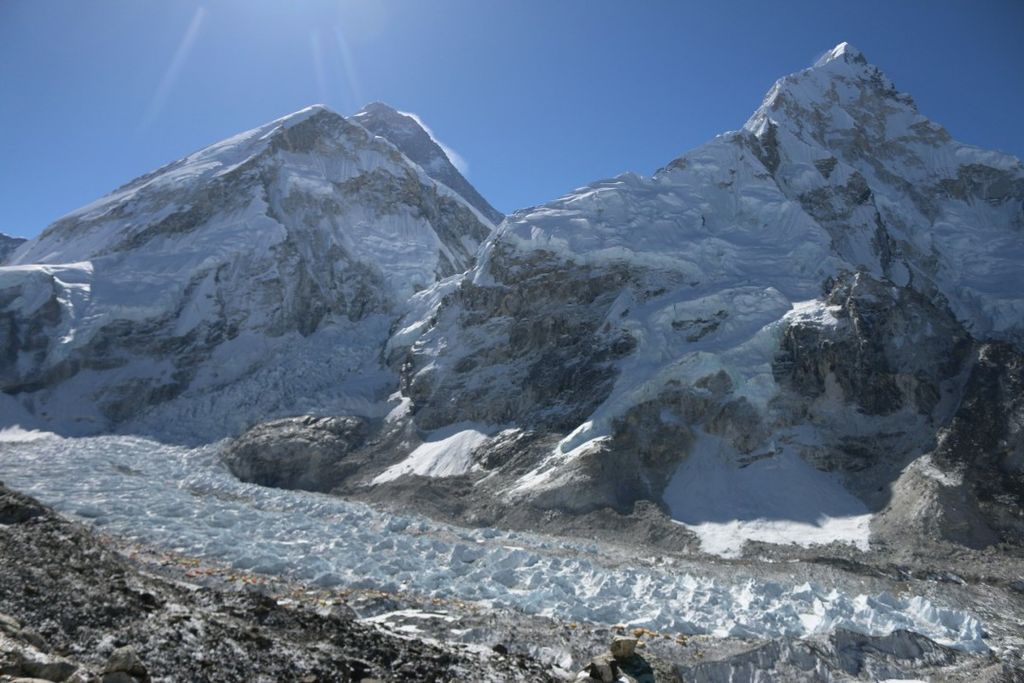
The Everest Base Camp (EBC) Trek is one of the world's most iconic and adventurous trekking experiences. This 12-14-day trek takes you through the heart of the Khumbu region, offering stunning views of Mount Everest (8,848m) and the surrounding Himalayan peaks. Along the way, you’ll pass through Sherpa villages, ancient monasteries, and vibrant markets in Namche Bazaar while crossing suspension bridges, glacial rivers, and high-altitude landscapes.
Reaching Everest Base Camp (5,364m) is a once-in-a-lifetime achievement, and the breathtaking sunrise from Kala Patthar (5,545m) provides the best panoramic view of Everest. With rich culture, challenging trails, and rewarding scenery, the EBC trek is a bucket-list adventure for every trekker and nature lover.
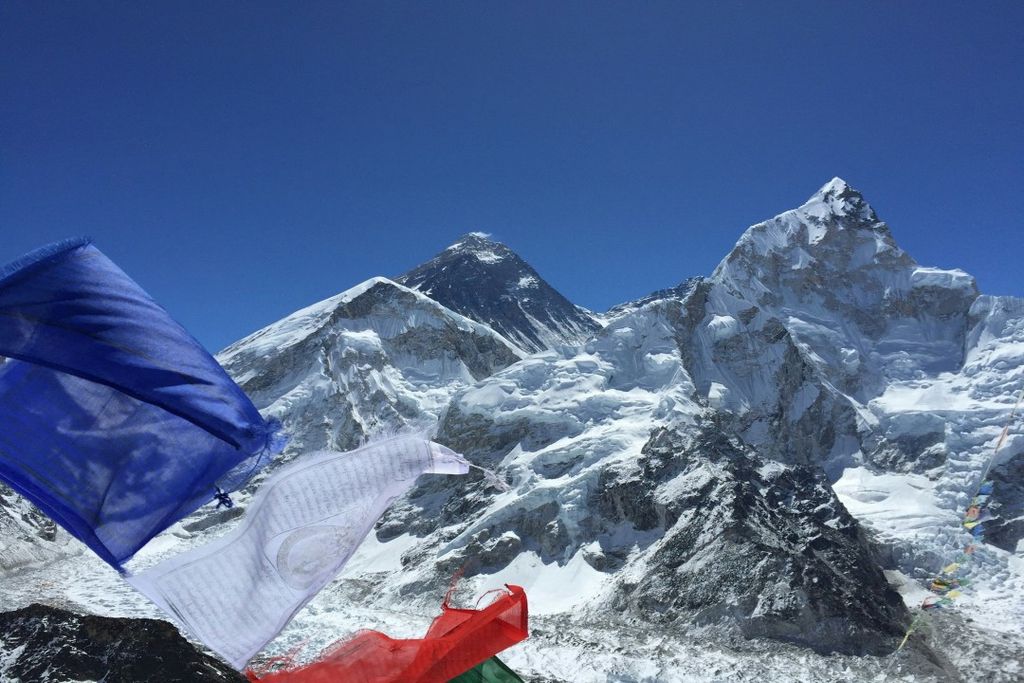
Everest Base Camp Trek Difficulty Level Explained
The Everest Base Camp (EBC) trek is moderate to challenging, mainly due to the high altitude, long trekking days, and unpredictable weather conditions. While it does not require technical climbing skills, it demands good physical fitness, endurance, and mental resilience.
1. Key Factors That Make EBC Trek Challenging
High Altitude (5,364m / 17,598ft)
Difficulty: Challenging due to Acute Mountain Sickness (AMS) risk.
Why? The oxygen level at 5,000m is 50% lower than at sea level, making breathing difficult.
Prevention: Acclimatization, slow ascent, and hydration.
Long Trekking Days (130km round trip)
Difficulty: Moderate to difficult due to walking 5-7 hours daily for 12-14 days.
Why? The rough terrain and steep ascents/descents require stamina.
Tip: Train with long hikes, cardio, and endurance exercises.
Weather & Temperature Extremes
Difficulty: Moderate to challenging, depending on the season.
Why? Cold temperatures (-10°C to -20°C), snowfall, or sudden weather changes can make trekking tougher.
Tip: Trek in Spring (March- May) or Autumn (Sept- Nov) for better weather.
Uneven Terrain & Altitude Gain
Difficulty: Moderate – No technical climbing is needed, but steep ascents, rocky paths, and suspension bridges make it challenging.
Why? Daily altitude gain of 300m-800m increases fatigue.
Tip: Use trekking poles to reduce knee strain.
2. Who Can Do the Everest Base Camp Trek?
Best for:
Fit individuals with good endurance.
Experienced trekkers or those who have done multi-day hikes before.
People willing to train at least 2-3 months before the trek.
Not Ideal for:
Those with serious heart or lung conditions.
People who can’t handle cold weather or altitude.
Anyone unprepared to walk 5-7 hours daily.
3 Tips to Make the Trek Easier
Train Before the Trek – Do cardio, leg strength, and endurance exercises.
Acclimatize Properly – Take rest days at Namche (3,440m) and Dingboche (4,410m).
Hydrate & Eat Well – Drink 3-4 liters of water daily and eat energy-rich meals.
Use Trekking Poles – Reduce strain on knees and improve stability.
Hire a Guide & Porter – Makes the trek easier and safer.
Conclusion: Moderate to Challenging
The Everest Base Camp trek is difficult but achievable with proper training and preparation. It’s not a technical climb, but the altitude, long trekking days, and cold temperatures make it challenging. Beginners can complete it with enough training and acclimatization!
How to Train for the Everest Base Camp (EBC) Trek
The Everest Base Camp trek is a challenging high-altitude adventure requiring stamina, strength, and endurance. A well-structured training plan will help you reduce fatigue, prevent injuries, and enjoy the trek.
How Fit Do You Need to Be?
You don’t need to be an athlete, but you should be able to:
Walk 5-8 hours a day for multiple days
Handle steep ascents & descents
Trekking at high altitudes (up to 5,364m)
Carry a 5-7 kg backpack
A structured 8-12 week training program will help you build stamina, strength, and endurance.
Training ideas:
1. Cardiovascular Endurance Training
Since you’ll be trekking 5-8 hours daily for 12+ days, improving your cardiovascular fitness is crucial.
Hiking & Walking: The best way to prepare is long walks on uneven terrain while carrying a backpack.
Running / Jogging: Aim for 5-10 km runs to improve endurance.
Cycling / Swimming: Great alternatives to build stamina and lung capacity.
Stair Climbing: Strengthens leg muscles and simulates uphill trekking.
2. Strength Training
Stronger legs, core, and upper body will help you tackle steep ascents and descents.
Leg Exercises: Squats, lunges, step-ups, leg presses.
Core Strength: Planks, sit-ups, Russian twists (improve balance).
Upper Body Strength: Push-ups, shoulder presses (for carrying a backpack).
3. Altitude & Acclimatization Training
Since EBC reaches 5,364m (17,598 ft), preparing for low oxygen levels is important.
Train at high-altitude locations (if available).
Simulate altitude using a stair-stepper with a mask or sleeping in a hypoxic tent.
Practice slow and steady trekking (no rushing!).
4. Stamina and Endurance
The EBC trek requires continuous daily walking, so long hikes with a loaded backpack (5-10kg) will prepare you for real conditions.
Trek on uneven terrain with a backpack to build endurance.
Start with 5-10 km hikes and gradually increase distance and difficulty.
Use trekking poles to reduce strain on knees.
5. Flexibility & Recovery
Stretching exercises (before and after workouts).
Yoga for flexibility & breathing control.
Rest days are crucial to avoid overtraining and injuries.
Note: Start training at least 8-12 weeks before your trek. Stay consistent & gradually increase difficulty.
Final Tips for Success
Break in your trekking boots before the trek.
Train with a loaded backpack to get used to the extra weight.
Stay hydrated & maintain a balanced diet.
Practice slow breathing for altitude adaptation.
Listen to your body & avoid overtraining.
With the right training, your EBC trek will be an unforgettable experience!
How to Increase Stamina for High-Altitude Trekking
High-altitude trekking, like the Everest Base Camp (EBC) trek, requires strong lungs, endurance, and stamina due to low oxygen levels. Here’s how to improve your stamina and endurance for a successful trek.
1. Build Cardiovascular Endurance
Since high-altitude trekking involves long hours of walking with reduced oxygen, improving your heart and lung capacity is crucial.
Best Cardio Workouts
Hiking / Walking – Walk 5-10 km with a backpack (5-7 kg).
Running / Jogging – Start with 3-5 km runs, and increase gradually.
Cycling / Swimming – Low-impact endurance workouts.
Stair Climbing – Strengthens legs and simulates uphill trekking.
Training Plan:
3-5 sessions per week (30-60 minutes each).
Gradually increase intensity and duration.
2. Train for Low Oxygen Levels (Altitude Acclimatization)
At higher altitudes, oxygen levels are lower, making breathing harder.
How to Prepare
Train at high-altitude locations (if possible).
Use a stair-stepper with a weighted vest to simulate altitude.
Practice deep breathing exercises (yoga, Pranayama).
Try altitude simulation masks (optional, but helpful).
Goal: Improve your body's ability to work with less oxygen.
3. Strength Training for Trekking
Strong legs, core, and upper body help with stamina, stability, and endurance.
Best Strength Exercises
Legs: Squats, Lunges, Step-ups, Calf Raises.
Core: Planks, Russian Twists, Leg Raises.
Upper Body: Push-ups, Shoulder Press, Deadlifts (for backpack carrying).
Training Plan:
Strength training 2- 3x per week (30-45 minutes per session).
4. Endurance Hiking
The best training for trekking is actual trekking!
How to Train
Weekend hikes (10-15 km) with a loaded backpack (5-7 kg).
Walk on uneven terrain & hills to train for real conditions.
Use trekking poles to reduce knee strain.
Training Plan:
1 long hike per week, increasing distance gradually, Improving lung Capacity (Breathing Exercises). At high altitudes, stronger lungs help you breathe efficiently. Practice for 5-10 minutes daily.
Best Breathing Techniques
Diaphragmatic Breathing: Deep belly breaths to maximize oxygen intake.
Box Breathing: Inhale for 4 seconds, hold, and exhale.
Pranayama (Yoga Breathing): Helps control breath at altitude.
6. Nutrition & Hydration
A well-balanced diet and proper hydration boost stamina and recovery.
Diet Tips for Endurance
Eat complex carbs for long-lasting energy.
Eat protein-rich foods for muscle recovery.
Eat healthy fats for endurance.
Hydrate well – Drink 3-4 liters of water daily.
7. Rest & Recovery
Your body needs time to adapt and grow stronger.
Recovery Tips
Take rest days to prevent injuries.
Sleep 7-9 hours per night for better stamina.
Stretching & Yoga to prevent stiffness.
Final Tips
Start training 2-3 months before your trek.
Gradually increase difficulty – don't overtrain!
Train with a backpack to prepare for real trekking conditions.
Listen to your body – rest if needed to avoid burnout.
With consistent training and the right mindset, you’ll build the stamina needed for high-altitude trekking and confidently enjoy the Everest Base Camp trek!
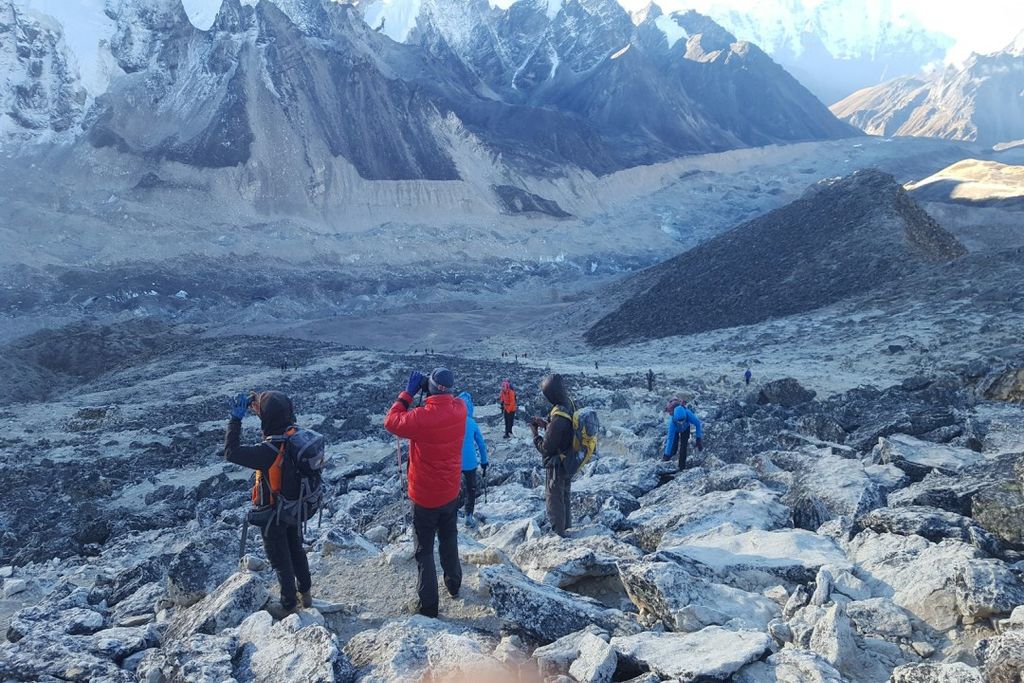
Best time to do the Everest Base Camp Trek
Understanding the Seasons in Nepal: Nepal experiences four main seasons, each offering a different trekking experience:
Spring (March- May)
Summer/Monsoon (June-August)
Autumn (September-November)
Winter (December- February)
Let's explore each season in detail and discuss the best time to trek to Everest Base Camp.
1. Spring (March to May) – The Best Season for EBC Trek
Why Spring is the Best Time?
Spring is one of the most popular times to trek to Everest Base Camp. The weather is mild, the skies are generally clear, and the trail is adorned with blooming rhododendrons, making the journey picturesque.
Weather Conditions:
Daytime temperatures: 10°C to 20°C at lower elevations.
Nighttime temperatures: -10°C to -15°C at higher elevations.
Minimal rainfall, clear skies, and comfortable trekking conditions.
Advantages:
Stable Weather: Less chance of snowfall or heavy rain.
Clear Views: Excellent visibility of Everest and other Himalayan peaks.
Comfortable Temperatures: Neither too cold nor too hot.
Beautiful Scenery: Blooming rhododendrons, lush green forests, and vibrant landscapes.
Mountaineering Season: Many climbers attempt to summit Everest, adding to the excitement.
Challenges:
Crowded Trails: High demand means more trekkers on the route.
Higher Costs: Peak season leads to higher prices for flights, accommodations, and trekking permits.
2. Summer/Monsoon (June to August) – The Least Recommended Time
Why is Summer not Ideal for the EBC Trek?
The monsoon season brings heavy rain, making the trail wet, slippery, and prone to landslides. Additionally, clouds and fog often obscure mountain views.
Weather Conditions:
Daytime temperatures: 15°C to 25°C at lower elevations.
Nighttime temperatures: 0°C to -5°C at higher elevations.
High humidity and frequent rain showers.
Advantages:
Fewer Trekkers: Less crowded trails and easier access to accommodations.
Lush Scenery: Green landscapes and beautiful waterfalls.
Lower Costs: Off-season discounts on flights and lodging.
Challenges:
Heavy Rainfall: Slippery trails, potential landslides,
Poor Visibility: Clouds and fog often obscure mountain views.
Flight Cancellations: High chances of delays or cancellations due to bad weather.
3. Autumn (September to November) – The Best Alternative to Spring
Why Autumn is Another Great Time?
Autumn is the most popular trekking season due to stable weather, clear skies, and perfect conditions. After the monsoon, the fresh air offers breathtaking views of Everest and the surrounding peaks.
Weather Conditions:
Daytime temperatures: 10°C to 20°C at lower elevations.
Nighttime temperatures: -10°C to -15°C at higher elevations.
Dry and stable conditions with excellent visibility.
Advantages:
Best Visibility: Crisp, clear skies provide stunning mountain views.
Comfortable Weather: Neither too hot nor too cold.
Festive Atmosphere: Major festivals like Dashain and Tihar fall in this season, adding cultural experiences.
Stable Weather: Less risk of rain or snow.
Challenges:
Crowded Trails: Many trekkers, making it difficult to find accommodation.
Higher Prices: Similar to spring, the demand increases costs.
4. Winter (December to February) – The Coldest Time to Trek
Why Can Winter Be Challenging?
Winter trekking to Everest Base Camp is possible but comes with harsh conditions. Snowfall can block passes, and temperatures can drop drastically.
Weather Conditions:
Daytime temperatures: 5°C to 10°C at lower elevations.
Nighttime temperatures: -15°C to -25°C at higher elevations.
Extremely cold with chances of heavy snowfall.
Advantages:
Fewer Crowds: Quieter trails and better availability of accommodation.
Clear Skies: Beautiful, crisp winter views.
Unique Experience: A completely different experience with snow-covered landscapes.
Challenges:
Extremely Cold: Harsh conditions make trekking difficult.
Blocked Trails: Heavy snow can close some sections.
Shorter Days: Less daylight means less trekking time.
Conclusion: When Should You Trek to Everest Base Camp?
The best time to trek to Everest Base Camp depends on your preferences and tolerance for weather conditions:
Best Overall: Spring (March- May) and Autumn (September- November)
Least Recommended: Monsoon (June-August)
For Adventure Seekers: Winter (December- February)
Spring and Autumn are your best options if you want stable weather, clear views, and a great trekking experience. Winter could be an adventurous choice for those looking for a less crowded experience and are prepared for cold temperatures. However, trekking during the monsoon season is not advisable due to poor visibility and difficult trail conditions. Choosing the right season and preparing accordingly can ensure a successful and memorable trek to Everest Base Camp.
Everest Base Camp Trek Itinerary (12 Days)
The Everest Base Camp (EBC) trek is a thrilling journey through the Himalayas, offering breathtaking landscapes, Sherpa culture, and stunning views of Mt. Everest (8,848m). Below is a standard 12-day itinerary (excluding arrival and departure days).
Day 1: Flight to Lukla (2,840m) & Trek to Phakding (2,610m) – 3-4 hrs
Day 2: Trek to Namche Bazaar (3,440m) – 6-7 hrs
Day 3: Acclimatization in Namche Bazaar (Rest Day)
Day 4: Trek to Tengboche (3,860m) – 5-6 hrs
Day 5: Trek to Dingboche (4,410m) – 5-6 hrs
Day 6: Acclimatization in Dingboche (Rest Day)
Day 7: Trek to Lobuche (4,910m) – 5-6 hrs
Day 8: Trek to Everest Base Camp (5,364m) & Back to Gorak Shep (5,164m) – 7-8 hrs
Day 9: Hike to Kala Patthar (5,545m) & Trek to Pheriche (4,210m) – 6-7 hrs
Day 10: Trek to Namche Bazaar (3,440m) – 6-7 hrs
Day 11: Trek to Lukla (2,840m) – 6-7 hrs
Day 12: Flight Back to Kathmandu
Optional: Add Extra Days for Acclimatization or Side Trips
- Day 13-14: Buffer days in case of flight delays in Lukla.
- Extra Rest Day: Recommended for first-time trekkers.
- Side Trips: Gokyo Lakes, Island Peak, or Everest Three Passes Trek.
This itinerary is ideal for gradual acclimatization and the best trekking experience.
Food and Accommodation on the Everest Base Camp Trek
The Everest Base Camp (EBC) trek offers basic but comfortable lodges (teahouses) along the trail. These provide meals, rooms, and basic facilities, making it easier for trekkers to enjoy the journey without carrying camping gear.
Food on the EBC Trek
Teahouses serve simple, nutritious meals that provide enough energy for trekking. The menu is almost the same throughout the trek, but prices increase as you go higher.
Common Foods Available - Breakfast Options
Tibetan Bread with Jam, Honey, or Peanut Butter
Porridge (Oatmeal, Rice, or Cornflakes)
Pancakes (Banana, Apple, or Chocolate)
Chapati with Eggs or Cheese
Masala Tea / Coffee
Lunch & Dinner
Dal Bhat – A classic Nepali meal (rice, lentil soup, vegetable curry, pickle, and papad) (Unlimited refills!)
Noodles – Veg or Chicken Thukpa (Tibetan noodle soup), Chow Mein
Fried Rice – Veg, Egg, or Chicken Fried Rice
Momos (Dumplings) – Steamed or Fried (Veg/Chicken)
Pasta & Spaghetti – Veg or Cheese Sauce
Pizza – Available in Namche & Lukla
Soups – Garlic Soup (good for altitude), Tomato, Mushroom, Noodle Soup
Potatoes – Fried, Boiled, or Stuffed (Sherpa Style)
Omelettes & Scrambled Eggs – Served with bread or chapati
Snacks & Drinks
Hot Drinks – Milk Tea, Black Tea, Lemon Tea, Masala Tea, Ginger Tea, Coffee
Cold Drinks – Bottled Water, Soft Drinks, Fresh Juice (in Namche)
Energy Bars, Chocolates, and Biscuits are available at teahouses but are expensive.
Pro Tip: Bring snacks like protein bars, dried fruits, nuts, and chocolates for extra energy.
Accommodation on the EBC Trek
Accommodation on the EBC trek is teahouse-based, meaning simple lodges run by local families.
What to Expect in Teahouses
Rooms: Twin-sharing basic rooms with wooden beds, blankets, and pillows.
Toilets: Lower-altitude lodges have attached bathrooms, but higher up, toilets are mostly shared (squat or Western-style).
Hot Showers: Available for an extra cost (~$5 per shower).
WiFi & Charging: Available at most teahouses (extra charge $3-$5 per device).
Dining Area: A warm common room with a fireplace, where trekkers gather for meals.
Sleeping Bags: Some lodges provide blankets, but a -10°C to -20°C sleeping bag is recommended for colder nights.
Final Tips for Food & Accommodation
Book teahouses in peak seasons (Autumn & Spring) to avoid last-minute issues.
Bring a refillable bottle & water purification tablets to avoid buying expensive bottled water.
Eat Dal Bhat for energy – It’s the best meal for long trekking days.
Carry some extra cash in rupees ($200-$300 equivalent) in small bills for food, accommodation, and additional charges.
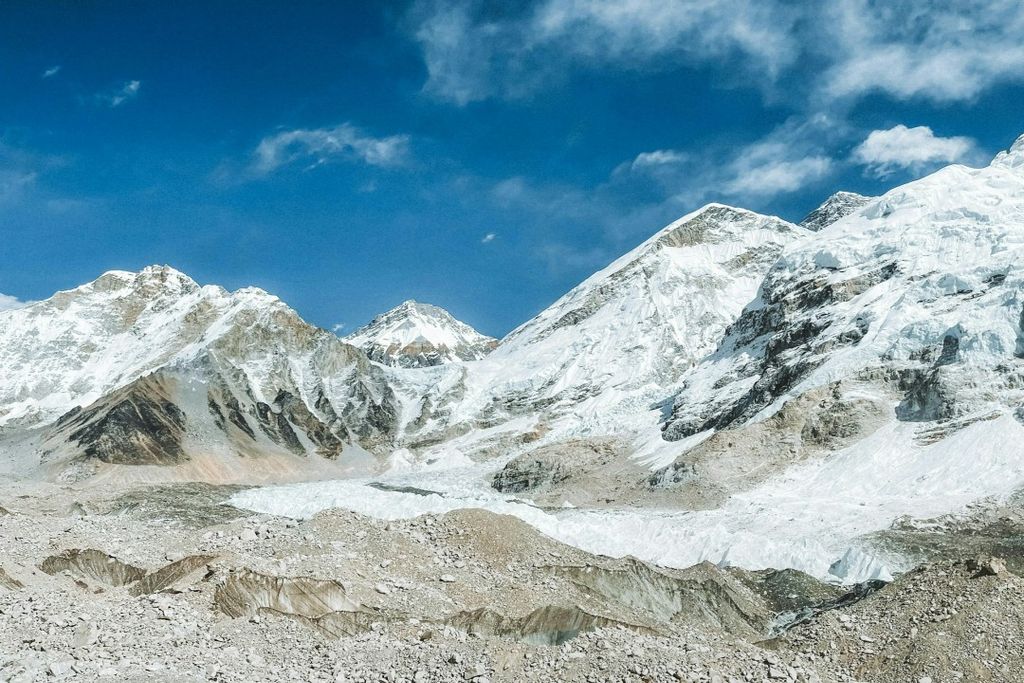
How to Find a Trekking Guide for Everest Base Camp Trek
Hiring a licensed trekking guide for the Everest Base Camp (EBC) trek is highly recommended for safety, navigation, and cultural insights. Here’s how to find a reliable guide for your trek:
1. Book Through a Trekking Agency
Registered trekking companies in Nepal provide experienced, licensed guides.
They handle permits, logistics, and accommodations for you.
Guides from agencies are well-trained in altitude sickness management & first aid.
Where to Find Agencies?
- 2000+ trekking companies are in Nepal
- Online Platforms – Search for agencies on Trekking Agencies’ Association of Nepal (TAAN) or travel sites like TripAdvisor & Lonely Planet.
- Local Recommendations – Ask fellow trekkers for referrals.
2. Hire an Independent Licensed Guide
More budget-friendly than agency guides.
You can negotiate directly and customize your itinerary.
Ensure they have a valid government trekking guide license (issued by the Nepal Tourism Board).
Where to Find Independent Guides?
- Word of Mouth – Ask experienced trekkers for referrals.
- Guide Directories – Websites like TrekkingPartners.com or social media groups.
Kathmandu Trekking Offices – Some freelance guides operate from Thamel.
Warning: Some self-proclaimed guides lack first-aid training & insurance, so always verify their credentials and trekking with an independent guide your travel insurance may not cover if things happen.
Guide Cost for Everest Base Camp Trek
Licensed Guide: $25 - $40 per day
Porter (only): $20 - $25 per day
Includes: Salary, food, accommodation, and insurance (for agency guides).
Final Tips
Check Their Experience – Ask how often they’ve done the EBC trek.
Verify Their License – Ensure they are government-certified.
Read Reviews – Look for past trekkers’ feedback.
Confirm First Aid Training – A good guide knows how to handle altitude sickness.
Symptoms and prevention of altitude sickness on Everest trek
Symptoms of Altitude Sickness (AMS)
Altitude sickness can occur above 2,500m (8,200ft) and becomes more common as you go higher.
Mild Symptoms (AMS – Acute Mountain Sickness)
Headache (most common sign)
Dizziness & Lightheadedness
Nausea or Loss of Appetite
Fatigue & Weakness
Shortness of Breath
Disturbed Sleep & Insomnia
Moderate to Severe Symptoms (HACE & HAPE – Life-Threatening Altitude Sickness)
High Altitude Cerebral Edema (HACE) – Swelling of the brain
- severe headache, confusion, loss of coordination, difficulty walking, hallucinations, unconsciousness.
- Treatment: Immediate descent & medical attention.
High Altitude Pulmonary Edema (HAPE) – Fluid buildup in the lungs
- Severe breathlessness (even at rest), blue lips/fingertips, chest tightness, gurgling sound when breathing, extreme fatigue.
- Treatment: Immediate descent & oxygen therapy.
Prevention of Altitude Sickness on EBC Trek
1 Acclimatization is Key
Follow the "climb high, sleep low" rule.
Take at least two acclimatization days (Namche Bazaar & Dingboche).
Gain altitude gradually (300-500m per day above 3,000m).
2 Stay Hydrated
Drink at least 3-4 liters of water per day.
Avoid caffeine & alcohol, as they cause dehydration.
3. Eat a High-Carb Diet
Carbs help your body process oxygen more efficiently.
Eat Dal Bhat, pasta, rice, soups, and potatoes.
4 Walk Slowly & Don’t Rush
Trek at a comfortable pace – slow & steady.
Avoid running or rapid ascents.
5 Take Altitude Medication (Diamox)
Acetazolamide (Diamox) helps speed up acclimatization.
Recommended 125mg-250mg twice daily, starting one day before ascent.
Consult a doctor before use (some may have allergies).
6 Recognize Symptoms & Act Early
If mild symptoms appear, rest at the same altitude or descend if symptoms worsen.
Never ignore headaches or dizziness.
7 Carry Oxygen & First Aid
Oxygen cylinders & portable altitude chambers (PAC bags) are available in some lodges.
Guides & teahouses often have oxygen supplies for emergencies.
7 Have Travel Insurance for Emergency Evacuation
Get insurance that covers helicopter evacuation, which covers evacuations below 6,000m in case of severe altitude sickness.
What to Do If You Get Altitude Sickness?
- Mild AMS: Rest, hydrate, eat, and take Diamox.
- Worsening Symptoms: Descend immediately (at least 300m).
- Severe Cases (HACE/HAPE): Emergency evacuation is required (Helicopter rescue is available).
Final Advice
Plan for extra acclimatization days for safety.
Listen to your body – Never ignore altitude sickness signs.
Take it slow & listen to your body.
Follow the standard itinerary with acclimatization days.
Stay hydrated & eat well.
Have proper travel insurance covering high-altitude helicopter rescue.
Everest Base Camp Trek Packing List
Packing wisely for the Everest Base Camp (EBC) trek is crucial for comfort, warmth, and safety, and layering is key since you’ll trek through diverse climates (from warm valleys to freezing altitudes). Here's a detailed packing list to help you prepare:
1 Essential Clothing
Base Layers (Moisture-Wicking & Thermal)
2-3 moisture-wicking t-shirts (quick-dry)
2-3 thermal base layers (for warmth at high altitudes)
Insulating Layers (Warm & Lightweight)
Fleece or down jacket (light but warm)
Softshell or synthetic jacket
Outer Shell (Waterproof & Windproof)
Windproof & waterproof jacket (Gore-Tex recommended)
Waterproof trekking pants
Trekking Pants & Shorts
2-3 pairs of lightweight trekking pants
1 pair of warm fleece pants (for cold nights)
Gloves & Accessories
Warm gloves (waterproof & insulated)
Lightweight gloves (for lower altitudes)
Warm beanie & sun hat
Neck gaiter or buff (protection from wind & dust)
Undergarments & Socks
3-4 pairs of moisture-wicking underwear
3-4 pairs of thick wool trekking socks
Sports bra (for women)
2. Trekking Gear & Equipment
Backpacks
40-50L backpack (for daily essentials)
Duffel bag (for porters) – If hiring one
Trekking Poles (Highly Recommended)
Reduces strain on knees, especially on descents
Sleeping Bag (Must-Have)
-10°C to -20°C sleeping bag (teahouses provide blankets but they may not be enough)
Headlamp & Extra Batteries
For early morning treks and power outages
Sunglasses (UV Protection)
Protects against strong UV rays at high altitudes
3. Footwear
Trekking Boots (Most Important!)
Waterproof, well-broken-in, and with ankle support
Camp Shoes/Sandals
Relaxing at teahouses
Gaiters (Optional but Useful)
Protects from snow, dust, and rain
4 Personal Items & Toiletries
Personal Hygiene
Toothbrush & toothpaste
Biodegradable wet wipes & tissues
Quick-dry towel
Lip balm with SPF
Sunscreen (SPF 50+)
Moisturizer (dry air at high altitudes)
Hand sanitizer
Toilet Kit
Small roll of toilet paper (many lodges don’t provide)
Pee funnel (for women, optional)
5 Medications & First Aid Kit
Must-Have Medications
Diamox (Acetazolamide) – For altitude sickness prevention
Painkillers (Ibuprofen/Paracetamol)
Anti-nausea & anti-diarrhea pills
Electrolyte powders (for hydration)
Band-aids & blister plasters
Personal prescriptions
Oxygen & Emergency Items
Guides carry oxygen tanks for emergencies
Portable altitude chamber (available in Pheriche)
6 Food & Snacks
Energy-Boosting Snacks
Granola bars, nuts, chocolate, dried fruits
Electrolyte powders or ORS (Oral Rehydration Salts)
Water Purification
Water purification tablets or SteriPEN (to avoid buying plastic bottles)
Reusable water bottles (2 liters capacity)
7 Travel Documents & Money
Must-Carry Documents
Passport & Nepali visa
Trekking permits (TIMS & Sagarmatha National Park Permit)
Travel insurance (covering high-altitude evacuation)
Cash (Very Important!)
Bring NPR (Nepali Rupees) – ATMs are unreliable after Namche Bazaar
Pro Packing Tips:
Pack light (Max 10-12kg for porters, 5-6kg for your backpack)
Use dry bags to keep clothes & electronics safe
Layering is the key to warmth & comfort
Test your gear before the trek
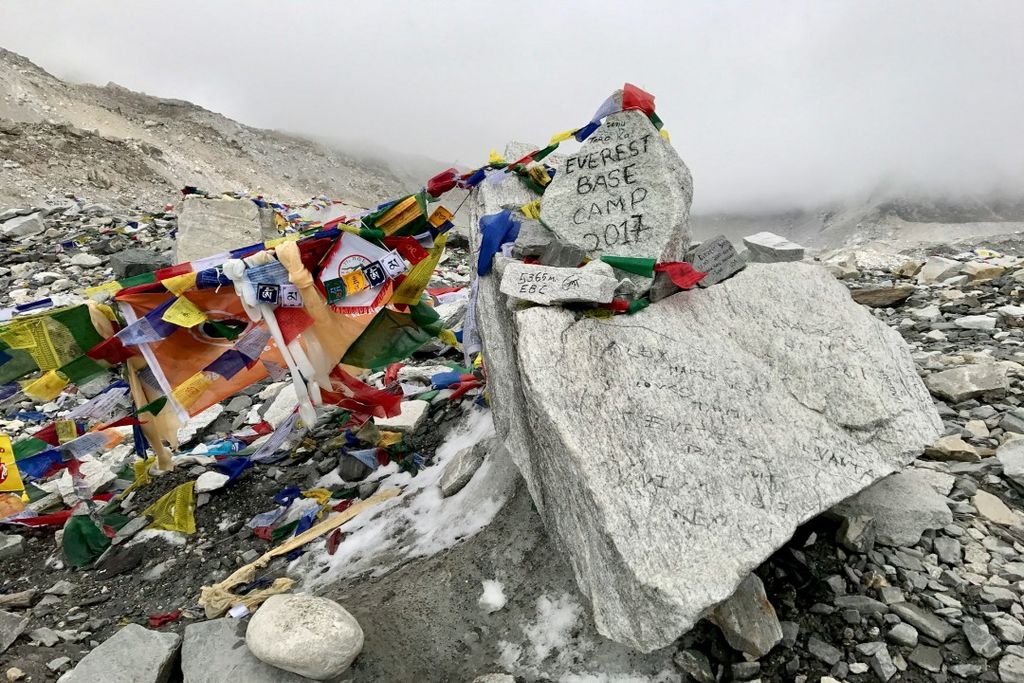
How much does the Everest Base Camp trek cost in 2025?
The cost of trekking to Everest Base Camp (EBC) in 2025 varies based on factors such as the choice between guided packages and independent trekking, the level of comfort desired, and additional personal expenses. Here's a breakdown to help you plan:
1. Guided Trek Package
Budget-friendly options typically range from $1000 to USD 1,200 per person. They cover essentials like permits, accommodations, meals, and the services of guides. While the amenities are basic, they ensure a reliable trekking experience.
Standard Packages: Expect to pay between $1,300 to $1,500 per person for standard 12 to 14-day treks. These packages often include permits, accommodations, meals, guide and porter services, and transportation to and from the trailhead.
Luxury Treks: Luxury treks can cost $2000 to $ 4000 or more for those seeking extra comfort. These packages offer superior accommodations, meals, and additional services.
2. Independent Treks
If you prefer trekking independently, consider the following approximate costs:
Accommodation: $10 to $20 USD per night.
Round-Trip Flights (Kathmandu to Lukla): Approximately USD 440.
Other Expenses (meals, permits, etc.): Around USD 400.
This brings the total to roughly $1,000 to USD 1,200, depending on personal spending habits and choices.
3. Additional Considerations
Equipment and Gear: Costs vary widely based on quality and personal preference.
Travel Insurance: Essential for high-altitude trekking, with costs varying by provider and coverage.
Visa Fees: A 15-day Visa costs 30 USD, and a 30-day visa costs $50 USD.
Tips for Guides and Porters: It's customary to tip, and this can add to your overall expenses.
4. Permit Fees
Ensure you obtain the necessary permits for the EBC trek:
Khumbu Pasang Lhamu Rural Municipality Entrance Permit: NPR 3,000 per person.
Sagarmatha National Park Entry Permit: NPR 3,000 per person.
These permits are essential for the trek.
5. Choosing the Right Package
When selecting a trekking package, consider the following:
- Inclusions: Ensure the package covers permits, accommodations, meals, guide and porter services, and transportation.
- Duration: Standard treks range from 12 days.
- Reputation: Research the trekking company’s reviews and testimonials.
For example, a 14-day EBC trek package, including necessary services, is available for USD 1,400 per person.
6. Final Tips
- Plan Ahead: Prices can fluctuate based on the season and demand.
- Budget for Extras: Allocate funds for personal expenses, souvenirs, and unforeseen costs.
- Stay Informed: Keep updated on any changes in permit fees or trekking regulations.
Considering these factors, you can effectively budget for your Everest Base Camp trek in 2025.
Everest Base Camp Trek: Spring vs. autumn – Which is better?
Both Spring (March- May) and Autumn (September- November) are the best seasons for the Everest Base Camp (EBC) trek, but each has its advantages and challenges. Here's a detailed comparison to help you decide which season suits you best.
Spring (March- May) – The Blooming Season
Pros:
Pleasant Temperatures: Days are warm (10-15°C at lower altitudes, -5°C at Base Camp).
Clear Mornings & Scenic Views: Great visibility with stunning snow-capped peaks.
Rhododendron Blooms: Lush forests with vibrant flowers in lower regions.
Less Cold than Autumn: Nights are cold but not as extreme as winter.
Good Trail Conditions: Less ice and snow compared to winter.
Cons:
Crowded Trails: Spring is the peak climbing season for Everest, so expect more trekkers.
Occasional Afternoon Clouds: Some haze in lower elevations, but it will not be a major issue.
More Expensive: Due to high demand, prices for flights, teahouses, and guides may be slightly higher.
Autumn (September-November) – The Clear Season
Pros:
Crystal Clear Skies: The best mountain visibility after the monsoon washes away dust and pollution.
Stable Weather: Dry and predictable, making trekking safer.
Comfortable Temperatures: Days are warm (10-15°C at lower altitudes, -10°C at Base Camp).
Festive Atmosphere: Major Nepali festivals like Dashain & Tihar enrich the experience.
Ideal for Photography: Sharp contrasts and stunning sunrise/sunset views.
Cons:
High Crowds: One of the busiest trekking seasons, full teahouses, and busier trails.
Colder Nights: Lower temperatures than in spring, especially in late November.
Limited Availability: Book flights, guides, and teahouses early.
Final Outcome: Which Season is better?
Choose Spring (March- May) if you prefer:
- Warmer temperatures (especially at night).
- Blooming flowers & green landscapes.
- Less crowded than autumn (but still busy).
Choose Autumn (Sept-Nov) if you prefer:
- Crystal clear mountain views & stable weather.
- Festive atmosphere with Nepali culture.
- More trekking groups for safety & socializing.
- If you love colorful landscapes and slightly warmer temperatures, go in Spring.
- If you want crisp views and stable weather, don’t mind the cold.
Best Time for Everest Base Camp Trek to Avoid Crowds
If you want to trek to Everest Base Camp (EBC) with fewer crowds, the best times to go are early spring (late February to early March) and late autumn (late November to early December). These periods balance good weather and fewer trekkers compared to peak seasons.
Least Crowded Times for EBC Trek
1 Late February – Early March (Pre-Spring)
Why? Fewer trekkers as the main spring trekking season hasn't fully started.
Weather: Cold mornings and nights (-10°C to -15°C at Base Camp), but clear skies.
Pros:
- Trails are less crowded, making for a peaceful trek.
- Beautiful snow-covered landscapes.
- Tea houses are open but not overbooked.
Cons:
- Colder than peak spring (March- May).
- Some passes might still have snow.
2 Late November – Early December (Post-Autumn)
Why? The peak autumn crowd is gone, but weather conditions are still good.
Weather: Cold but stable (10°C in lower regions, -10°C at Base Camp).
Pros:
- Clear skies and stunning views.
- Less competition for flights & accommodation.
- Still safe for solo trekking since some trekkers remain.
Cons:
- Colder nights and mornings (-10°C to -15°C).
- Some tea houses might start closing in December.
Times to Avoid If You Want Fewer Crowds
- Mid-March to May (Peak Spring) – Warm weather, rhododendrons blooming, but very crowded.
- Mid-September to Early November (Peak Autumn) – The busiest time with clear skies but full trails.
- June to August (Monsoon Season) – Fewer trekkers, but rain, clouds, and flight cancellations make it challenging.
- Mid-December to February (Winter) – Empty trails but extremely cold (-20°C at Base Camp), and some lodges close.
Conclusion: Best Quiet Periods for EBC Trek
Late February to early March: Cold but with fewer people, good snow-covered scenery.
Late November to Early December – Cold but stable weather and stunning views.
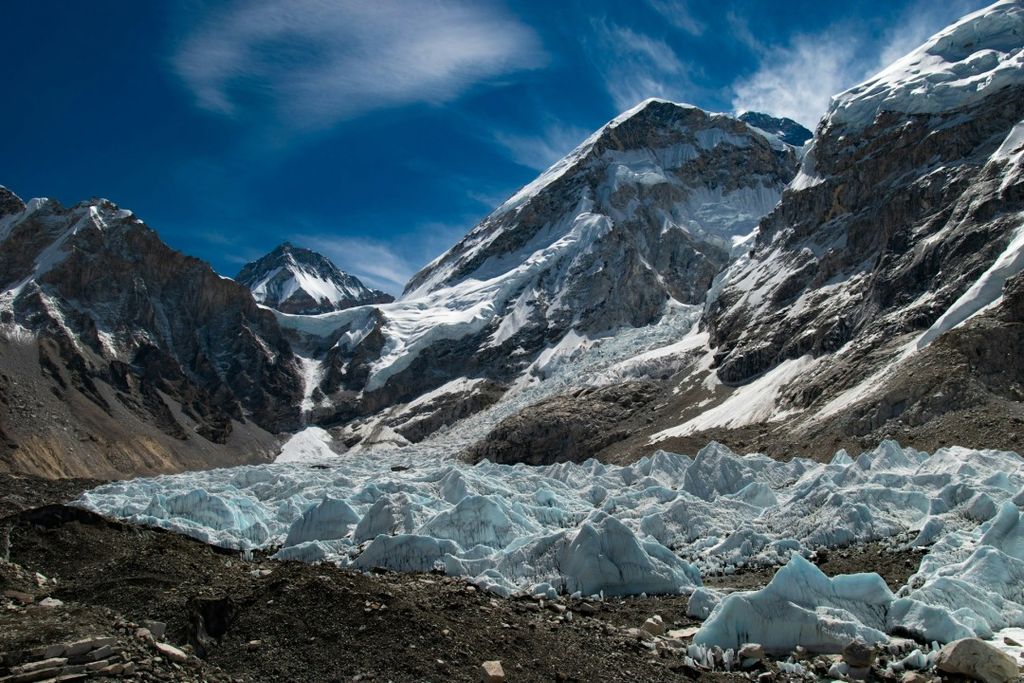
About the author
Sali Trekking
Saligram Aryal (Sali), the Managing Director of Sali Trekking, boasts over 25 years of guiding experience in the field of trekking and mountaineering. As the founder and director of Sali Trekking and Mountain World Treks and Expedition, he is based in Kathmandu, overseeing all aspects of pre-departure communication, trip organization, and financial management. Saligram is deeply passionate about the Himalayan landscapes, particularly those of the Everest, Langtang and Annapurna mountain ranges, and relishes the opportunity to lead treks in these regions. Saligram has a knack for making every client feel welcomed and at ease during their adventure.

Saligram Aryal
Saligram Aryal (Sali), the Managing Director of Sali Trekking, boasts over 25 years of guiding experience in the field of trekking and mountaineering. As the founder and director of Sali Trekking and Mountain World Treks and Expedition, he is based in Kathmandu, overseeing all aspects of pre-departure communication, trip organization, and financial management.
Recent Articles

Everest Base Camp
Apr 16, 2025

Ultimate Guide to Trekking in Nepal
Apr 10, 2025

Exploring Lumbini: The Birthplace of Buddha
Mar 26, 2025

Solo Trekking: Tips for a Safe and Enjoyable Journey
Mar 14, 2025
